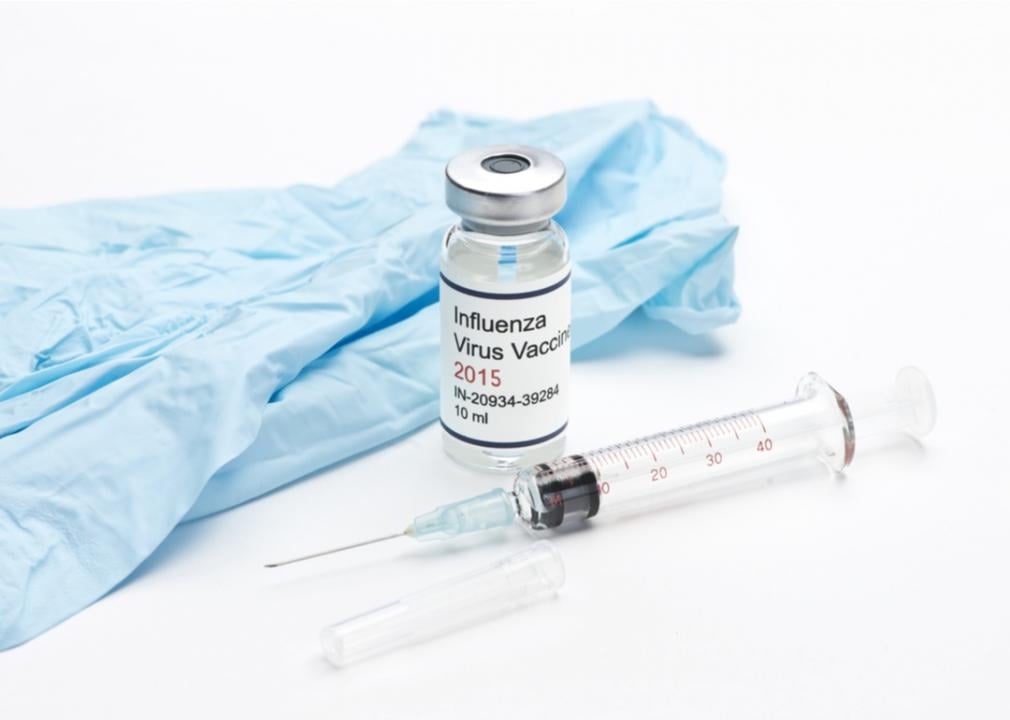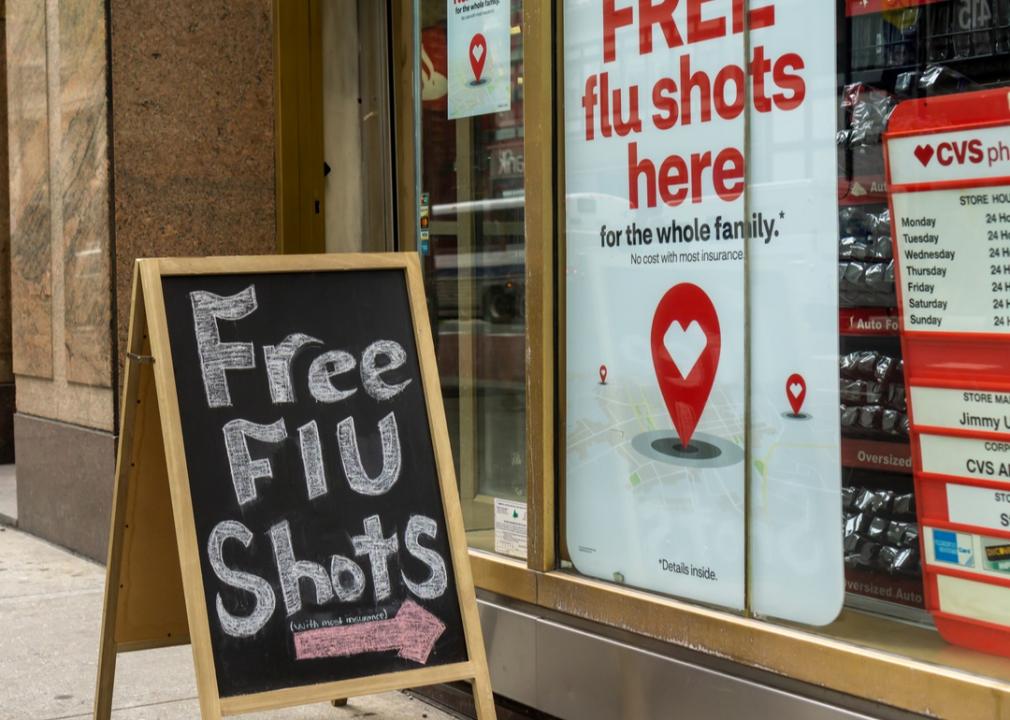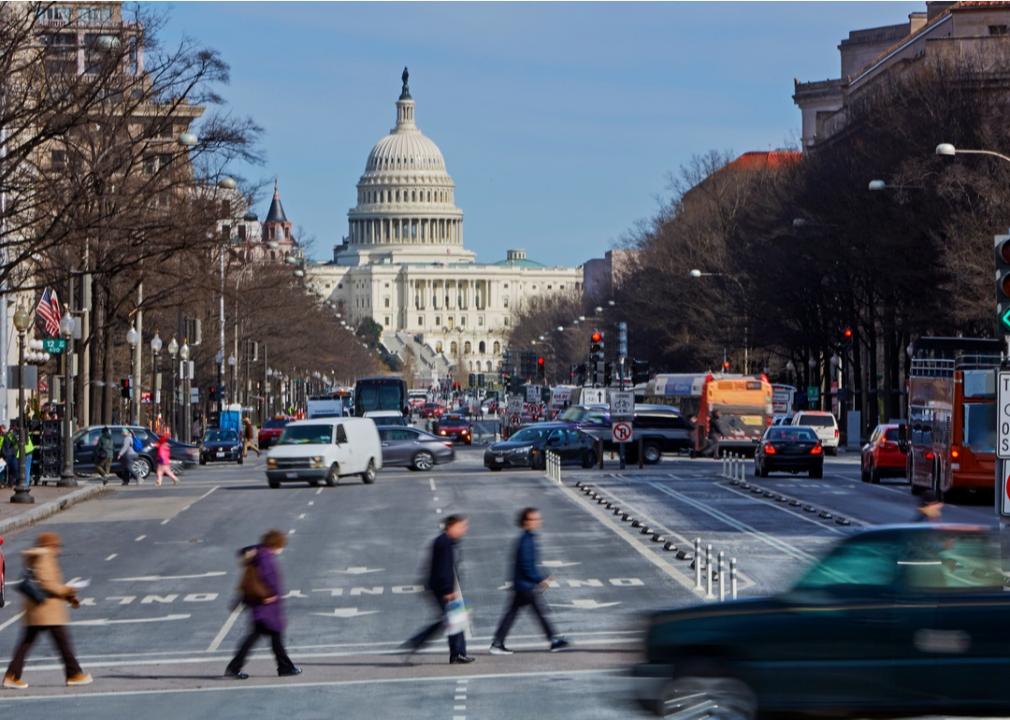States with the highest flu vaccination rates
Published 7:00 am Wednesday, November 24, 2021
Angyalosi Beata // Shutterstock
States with the highest flu vaccination rates
Your yearly flu vaccine protects you and those around you from the influenza virus, which could be deadly. You shouldn’t get vaccinated too early, or your immunity may be reduced by the time the flu virus starts circulating in your community. The Centers for Disease Control and Prevention (CDC) recommends getting a flu vaccine in September or October to prepare for the flu season in the late fall and winter.
Flu vaccines are updated each year to protect you against the viruses in circulation for the upcoming flu season. Vaccines are readily available through places such as health departments, community clinics, and pharmacies. It takes about two weeks after vaccination to produce enough antibodies to the virus to fully protect you against the flu.
Almost anyone over 6 months of age can get a flu vaccine, including pregnant women and most people with egg allergies. Flu vaccines are administered either as an intramuscular injection, usually in the upper arm, or as a nasal spray. Vaccines can protect you against three different strains of the flu virus (trivalent vaccines) or four different strains of the virus (quadrivalent vaccines).
The most common side effects of the injectable flu vaccine are soreness at the injection site, muscle aches, and a fever. The side effects of the nasal spray vaccine are the same but may also include a runny nose.
People over age 65 should get either a high-dose quadrivalent vaccine, which contains four times the flu antigen (which prompts your body’s immune response) of the standard vaccine, or an adjuvanted vaccine, which encourages a more robust immune response. In the U.S., both the high-dose vaccine and the adjuvanted vaccine are approved solely for people over 65.
To determine the flu vaccination coverage for every state, Stacker consulted the CDC’s Influenza Seasons Vaccination Coverage Trend Report. This source includes six-month coverage estimates based on surveys of residents in each state during flu seasons from 2010-2011 to 2020-2021. States are ranked based on their average vaccination coverage through these eleven seasons. Data are as of October 2021. There are no ties; results are based on numbers with further decimal points that have been rounded in the ranking.
You may also like: What to know about getting the flu vaccine this year
![]()
Khairil Azhar Junos // Shutterstock
#51. Nevada
– Average flu vaccination coverage, 2010-21: 38.4%
– 8.0% below national average
In June 2020, Nevada’s State Immunization Program received an extra $1.3 million from the CDC to expand the state’s flu vaccination campaign. The state program redirected funds to Immunize Nevada, a nonprofit dedicated to immunizations, and three local health districts, but the immunization rate hasn’t noticeably improved.
Impact Photography // Shutterstock
#50. Florida
– Average flu vaccination coverage, 2010-21: 39.1%
– 7.3% below national average
Florida saw the lowest flu vaccination rate of any state for the three seasons from 2017 to 2020. For the second year in a row, the Duval County Medical Society partnered with local news channel News4JAX for #FluVaxJax, a community-wide program to get people vaccinated against influenza. Last year, the campaign reached its goal of getting at least 48% of adults vaccinated against the flu in Clay, Duval, Nassau, and St. Johns counties—an improvement of nearly 10%. Uninsured residents of these counties can request a voucher online for a free vaccine.
Mark Winfrey // Shutterstock
#49. Wyoming
– Average flu vaccination coverage, 2010-21: 39.9%
– 6.5% below national average
Following an unusually mild 2020 flu season, the Wyoming Department of Health wants to remind residents not to overlook the flu shot as the COVID-19 pandemic continues. Dr. Alexia Harrist says the state is “concerned about the combined impact of both influenza and COVID-19 on our hospitals and on our state’s residents.” Wyoming’s public vaccine programs help protect some adults and children from vaccine-preventable diseases, such as the flu, at little to no cost for eligible patients.
Jacob L. // Shutterstock
#48. Idaho
– Average flu vaccination coverage, 2010-21: 40.0%
– 6.4% below national average
The Idaho Immunization Coalition oversees Get Immunized, Idaho, a vaccine advocacy group made up of scientists, medical professionals, and parents. In October 2021, the group sponsored a drive-through clinic where residents could get immunized against the flu and COVID-19 at no cost.
Ramunas Bruzas // Shutterstock
#47. Alaska
– Average flu vaccination coverage, 2010-21: 40.9%
– 5.5% below national average
The Alaska Native Tribal Health Consortium is offering flu vaccinations at the Alaskan Native Medical Center walk-in clinic in Anchorage. Flu vaccinations are available seven days a week at the clinic, located on Ambassador Drive in the Healthy Communities Building.
You may also like: The only 7 countries that are on track to meet the Paris Agreement—and how they’re doing it
VILevi // Shutterstock
#46. Georgia
– Average flu vaccination coverage, 2010-21: 41.8%
– 4.6% below national average
In Georgia, the department of public health’s “Yes, You!” campaign encourages all residents to get a flu vaccine. The campaign’s twin messaging emphasizes that everyone over the age of 6 months needs to be vaccinated against the flu, and there is a flu vaccine appropriate for everyone.
Sean Pavone // Shutterstock
#45. Arizona
– Average flu vaccination coverage, 2010-21: 41.9%
– 4.5% below national average
For the second year in a row, the Arizona Department of Health Services is promoting vaccination through their #RollUpYourSleeve campaign, which provides information on symptoms of influenza, places to get vaccinated, and statistics related to the current flu season. Dr. Cara Christ, director of the ADHS, said this campaign is necessary because increased demand for hospital beds from influenza cases could put a strain on resources marked for the fight against COVID-19.
Sean Pavone // Shutterstock
#44. Mississippi
– Average flu vaccination coverage, 2010-21: 42.2%
– 4.3% below national average
Organizations including the Mississippi Association of Family Physicians, the Mississippi chapter of the American Academy of Pediatrics, and the state health department have formed the Mississippi Flu Fighters Coalition to encourage residents to get vaccinated against the flu. The coalition can be followed on social media with the hashtag #FightFluMS.
MedStockPhotos // Shutterstock
#43. Oregon
– Average flu vaccination coverage, 2010-21: 43.2%
– 3.2% below national average
This fall, Oregon State University – Cascades hosted several walk-up and drive-through clinics providing free flu and COVID-19 vaccinations to students, teachers, and community members. The clinics were hosted in partnership with Deschutes County Health Services.
Karin Hildebrand Lau // Shutterstock
#42. Montana
– Average flu vaccination coverage, 2010-21: 43.4%
– 3.0% below national average
Pharm406, a pharmacy in Billings, continued its popular “Get a brew, not the flu” series this fall. Pharm406 staff set up a mobile vaccine clinic outside local brewpubs, and flu vaccinations come with a coupon for a free beer.
You may also like: 50 space terms for understanding the universe
Rawpixel.com // Shutterstock
#41. Louisiana
– Average flu vaccination coverage, 2010-21: 43.8%
– 2.6% below national average
The Louisiana Department of Health continued their Roll Up Your Sleeves, Louisiana campaign to encourage residents to get the flu vaccine. The free vaccines are available at walk-in and drive-through clinics throughout the state.
JDMcGauley // Shutterstock
#40. Indiana
– Average flu vaccination coverage, 2010-21: 43.8%
– 2.6% below national average
Since September 2021, the Indianapolis Motor Speedway has hosted a drive-through clinic offering flu shots alongside COVID-19 tests and vaccines. No appointments are required for flu vaccinations, which are available to all individuals regardless of insurance status. The site’s popularity meant that the state department of health extended the clinic through Nov. 20.
Sean Pavone // Shutterstock
#39. Michigan
– Average flu vaccination coverage, 2010-21: 43.9%
– 2.5% below national average
According to the Michigan Department of Health and Human Services, flu vaccination rates are down compared to previous years. As of Nov. 6, 2021, a little more than 2 million doses of flu vaccine have been administered, which is a 26% decrease from this time last year. A recent influenza outbreak at the University of Michigan spread to more than 525 students, and 77% of those infected had not been vaccinated.
Sean Pavone // Shutterstock
#38. Illinois
– Average flu vaccination coverage, 2010-21: 44.1%
– 2.3% below national average
The Chicago Department of Public Health hosted over 50 recurring flu vaccination clinics at locations across the city, urging everyone to get vaccinated against both the flu and COVID-19 so hospitals don’t get overwhelmed by a double epidemic.
Matt Gush // Shutterstock
#37. California
– Average flu vaccination coverage, 2010-21: 44.8%
– 1.6% below national average
This fall, the Los Angeles County Department of Public Health partnered with the LA County Library to hold 13 flu vaccine clinics. Health insurance was not necessary to receive a free flu vaccine.
You may also like: From Hypatia to Christina Koch: 50 groundbreaking women of science
f11photo // Shutterstock
#36. Texas
– Average flu vaccination coverage, 2010-21: 44.8%
– 1.6% below national average
Austin-based Flu Busters was founded by a nurse in 1997. The company runs on-site flu vaccination clinics, mostly at schools, state agencies, large companies, and other places of business. Flubusters serves Travis, Williamson, and Hays Counties.
stellamc // Shutterstock
#35. Utah
– Average flu vaccination coverage, 2010-21: 45.0%
– 1.4% below national average
The Southwest Utah Public Health Department resumed its annual “flu shootout” vaccination clinics in five counties this fall. The walk-in and drive-through events were free for those with insurance from certain providers and $20 for others.
PanyaStudio // Shutterstock
#34. Alabama
– Average flu vaccination coverage, 2010-21: 45.3%
– 1.1% below national average
The Medical Association of the State of Alabama, the Alabama Hospital Association, and the Alabama Department of Public Health have teamed up to encourage residents to get a flu vaccine. As part of this initiative, these organizations created a campaign toolkit for local care providers to utilize.
Big Fish Drones // Shutterstock
#33. Wisconsin
– Average flu vaccination coverage, 2010-21: 45.7%
– 0.7% below national average
This year, the Wisconsin Department of Health Services continued its “Be an InFLUencer” campaign to encourage flu vaccination among the state’s communities of color. The campaign includes social media engagement on several platforms and radio ads in English and Spanish.
Pedro Gutierrez // Shutterstock
#32. Ohio
– Average flu vaccination coverage, 2010-21: 46.3%
– 0.1% below national average
The Immunization Coalition of Central Ohio offers flu vaccination clinics for those who are underinsured or uninsured, are part of a high-risk category, or make less than $20,040 (individuals) or $27,000 (couples). The vaccines are free because of support from the Franklin County Health Commissioners, Franklin County Office on Aging, and the Osteopathic Heritage Foundation.
You may also like: 50 images of the universe from the Hubble Space Telescope
Kevin Ruck // Shutterstock
#31. South Carolina
– Average flu vaccination coverage, 2010-21: 46.4%
– equal to national average
The South Carolina Department of Health and Environmental Control offers flu vaccinations at select locations throughout the state. The department bills some Blue Cross/Blue Shield plans as well as state Medicaid and Medicare Part B to cover the cost of the vaccine.
f11photo // Shutterstock
#30. Kentucky
– Average flu vaccination coverage, 2010-21: 46.5%
– 0.1% above national average
Last year, the University of Kentucky announced that the school would require all students to receive a flu shot. This initiative is a collaboration between Kroger, the University of Kentucky College of Pharmacy, and the University Health Service.
APN Photography // Shutterstock
#29. Kansas
– Average flu vaccination coverage, 2010-21: 46.8%
– 0.4% above national average
The Immunize Kansas Coalition has launched the #KansasFightsFlu initiative to increase flu vaccination rates among residents. The initiative includes a training seminar for clinic staff as well as outreach materials for the public.
toodtuphoto // Shutterstock
#28. Missouri
– Average flu vaccination coverage, 2010-21: 47.0%
– 0.6% above national average
The Missouri Department of Health and Senior Services reported that last year’s low rate of influenza was likely due to increased citizen awareness of protection measures. On Oct. 19, 2021, Director Donald Kauerauf reminded Missourians that “getting your annual flu shot this fall is even more important this year as we continue to take action against COVID-19.” The department’s 2021 flu vaccine initiative is called #StickItToTheFlu.
Nolichuckyjake // Shutterstock
#27. Tennessee
– Average flu vaccination coverage, 2010-21: 47.4%
– 1.0% above national average
For the fourth year, county health departments in Tennessee held Fight Flu TN vaccination clinics in every county in the state. This year, Fight Flu TN was held on Nov. 9, 2021.
You may also like: States doing the most for a clean energy future
Juice Flair // Shutterstock
#26. Oklahoma
– Average flu vaccination coverage, 2010-21: 47.5%
– 1.1% above national average
For the sixth straight year, the Chickasaw Nation collaborated with county health departments in the central part of Oklahoma to hold flu vaccination clinics in the surrounding communities. The vaccines were also administered at local schools.
Sean Pavone // Shutterstock
#25. New Jersey
– Average flu vaccination coverage, 2010-21: 47.6%
– 1.2% above national average
On Jan. 13, 2020, Governor Phil Murphy signed legislation requiring all health care facility employees in the state to be vaccinated against the flu. The New Jersey Hospital Association has created a #NJFightsFlu toolkit full of resources for implementing the new mandate.
Jacob Boomsma // Shutterstock
#24. Arkansas
– Average flu vaccination coverage, 2010-21: 47.9%
– 1.5% above national average
The Arkansas Department of Health offered free flu vaccines at Local Health Units across the state starting on Sept. 21, 2021. The department also hosted flu vaccination clinics at schools.
rblfmr // Shutterstock
#23. New York
– Average flu vaccination coverage, 2010-21: 48.0%
– 1.6% above national average
On Sept. 27, 2021, the New York City Department of Health and Mental Hygiene announced its 2021 flu campaign with the tagline, “Wrong time for the flu. Right time for a flu shot.” The campaign ran in several languages, with ads on public transportation as well as in mainstream and social media.
Jacob Boomsma // Shutterstock
#22. New Mexico
– Average flu vaccination coverage, 2010-21: 48.2%
– 1.8% above national average
The University of New Mexico Hospital offered free flu vaccinations at several drive-through clinics this fall. The clinics were held at different locations across the Albuquerque metro area.
You may also like: Space discoveries that will blow your mind
PhotoItaliaStudio // Shutterstock
#21. Maine
– Average flu vaccination coverage, 2010-21: 49.1%
– 2.7% above national average
On Apr. 14, 2021, the Maine Center for Disease Control approved a mandate that requires all health care workers in the state to be vaccinated against the flu. Currently, 18 states require health care workers to be vaccinated against influenza. Health care workers must also be vaccinated against measles, mumps, German measles, chickenpox, hepatitis B, and COVID-19.
Real Window Creative // Shutterstock
#20. Washington
– Average flu vaccination coverage, 2010-21: 49.2%
– 2.8% above national average
In 2020, Washington experienced its first recorded death-free flu season. The state’s department of health is encouraging residents to repeat this phenomenon this year with a plan to “knock out flu again, Washington!”
Jacob Boomsma // Shutterstock
#19. North Dakota
– Average flu vaccination coverage, 2010-21: 49.3%
– 2.9% above national average
On Sept. 27, 2021, North Dakota state officials urged residents to get vaccinated ahead of this year’s flu season. “We don’t want to have flu cases on top of COVID cases stretching our hospital capacity, so that’s why it’s important to be vaccinated,” explained Molly Howell, state immunization manager.
Robert Hoetink // Shutterstock
#18. West Virginia
– Average flu vaccination coverage, 2010-21: 49.5%
– 3.1% above national average
This fall, the Veterans Affairs Medical Center in Clarksburg held drive-through flu vaccination events at its five locations. Veterans were able to get flu vaccines without appointments during the center’s four clinics.
Jacob Boomsma // Shutterstock
#17. Colorado
– Average flu vaccination coverage, 2010-21: 49.6%
– 3.2% above national average
Front Range Flu Shots of Littleton offers on-site flu vaccination clinics to businesses, schools, and other organizations in the Denver area. Registered nurses run the clinics, which accept most insurance plans.
You may also like: States with the biggest household carbon footprints
A G Baxter // Shutterstock
#16. District of Columbia
– Average flu vaccination coverage, 2010-21: 49.6%
– 3.2% above national average
On Oct. 12, 2021, D.C. mayor Muriel Bowser announced that the District’s walk-up vaccination clinics would begin offering influenza shots. Like the COVID-19 vaccine, flu shots are free to all at the District’s three vaccination sites.
Monkey Business Images // Shutterstock
#15. Pennsylvania
– Average flu vaccination coverage, 2010-21: 49.6%
– 3.2% above national average
In Pennsylvania, pharmacists can administer a flu vaccine to children 9 years old or older. Last year, Governor Tom Wolf signed a waiver suspending this age limitation, allowing pharmacists to administer the flu vaccine to children three years old or older. On Dec. 8, 2020, Wolf signed another waiver that allowed supervised pharmacy interns to administer the flu vaccine to children 3 years old or older.
Joseph Sohm // Shutterstock
#14. Vermont
– Average flu vaccination coverage, 2010-21: 49.9%
– 3.5% above national average
Last year, Vermont considered becoming the second state to approve a mandate requiring all school children to be vaccinated against the flu. The ruling didn’t pass, but the immunization program director at the Vermont Department of Health says the influenza vaccine is more important than ever, especially when considering the risk of flu co-circulating with COVID.
Sean Pavone // Shutterstock
#13. New Hampshire
– Average flu vaccination coverage, 2010-21: 50.2%
– 3.8% above national average
The North Country Health Consortium in Littleton held two drive-through clinics this fall to provide free flu vaccinations. The consortium is a non-profit network of health and service providers who collaborate to address public health issues in northern New Hampshire.
Jeffery Edwards // Shutterstock
#12. North Carolina
– Average flu vaccination coverage, 2010-21: 50.6%
– 4.2% above national average
On Sept. 13, public health officials in North Carolina issued a press release urging residents to protect themselves, their families, and those around them by getting a flu vaccine. The state’s resources were stretched as it balanced the start of flu season with a COVID-19 surge caused by the Delta variant.
You may also like: 15 basic physics concepts to help you understand our world
Leigh Trail // Shutterstock
#11. Hawaii
– Average flu vaccination coverage, 2010-21: 50.9%
– 4.5% above national average
The Hawaii chapter of the AFL-CIO partnered with My Health Solutions to hold a vaccination clinic on Oct. 2. The drive-through clinic, dubbed “Drive-Thru and Beat the Flu & COVID,” was held at Kakaako Waterfront Park in Honolulu.
Khairil Azhar Junos // Shutterstock
#10. Delaware
– Average flu vaccination coverage, 2010-21: 51.0%
– 4.6% above national average
This fall, the Delaware Division of Public Health hosted flu clinics for anyone aged 9 or older without a healthcare provider or whose insurance does not cover the vaccine. Another set of clinics were held for children between 6 months and 18 years old. People with Medicare or Medicaid had their insurance billed accordingly, and donations were accepted from those without coverage.
Photographee.eu // Shutterstock
#9. Virginia
– Average flu vaccination coverage, 2010-21: 51.4%
– 5.0% above national average
The Virginia Beach Department of Public Health hosted several free flu vaccination clinics this fall. EMS personnel and volunteer nurses from the Virginia Beach Medical Reserve Corps administered the vaccines at the drive-through events.
Aspects and Angles // Shutterstock
#8. Nebraska
– Average flu vaccination coverage, 2010-21: 51.5%
– 5.1% above national average
Blue Cross and Blue Shield of Nebraska and the YMCA partnered to run flu vaccination clinics in October 2021 at 14 YMCAs across the state. The clinics were free of charge to everyone age 6 and older, regardless of insurance coverage.
Ken Wolter // Shutterstock
#7. Minnesota
– Average flu vaccination coverage, 2010-21: 51.7%
– 5.3% above national average
Since 1998, UCare, Hennepin Healthcare, and KARE-11 TV have partnered to host Health Fair 11, a multi-day flu vaccination clinic at the Minnesota State Fairgrounds. This year the event was held on Saturday, Sept. 25, and Sunday, Sept. 26. Nurses with Hennepin Healthcare administered the vaccines on a first-come, first-serve basis to people age 6 months and older.
You may also like: The pioneering life of Bill Nye—from science celeb to space innovator
JamesPatrick.pro // Shutterstock
#6. Iowa
– Average flu vaccination coverage, 2010-21: 51.9%
– 5.5% above national average
Medicap Pharmacy partnered with the Food Bank of Iowa again this fall, donating 12 meals to the local food pantry for every flu vaccine given at participating locations. The program runs from Sept. 22 to Nov. 22, 2021.
Bruce Peter // Shutterstock
#5. Connecticut
– Average flu vaccination coverage, 2010-21: 52.4%
– 6.0% above national average
The Connecticut Department of Public Health began their 2021 flu vaccination campaign with a CDC graphic that called for Connecticut residents to #SleeveUp to #FightFlu. Through the Connecticut Vaccine Program, children under 18 are eligible for a free influenza vaccination.
Real Window Creative // Shutterstock
#4. Maryland
– Average flu vaccination coverage, 2010-21: 52.7%
– 6.3% above national average
Maryland Department of Health’s 2021 flu vaccine campaign encourages eligible Marylanders to consider getting a COVID-19 booster at the same time as their flu shot. Secretary Dennis R. Schrader reminded residents, “You should get a flu shot, regardless of whether you’ve received the COVID vaccination. If you are not vaccinated yet against COVID or if you need a booster shot, you can safely get the flu and COVID shots at the same time.”
Erickson Stock // Shutterstock
#3. Massachusetts
– Average flu vaccination coverage, 2010-21: 54.9%
– 8.5% above national average
In 2020, Massachusetts became the first state to require that schoolchildren be vaccinated against the flu. The requirement applied to children 6 months of age or older who attend daycare, kindergarten, K-12, and colleges and universities. However, this year, health officials removed the requirement, citing a mild flu season and the need to focus resources on COVID-19 vaccination.
Ken Wolter // Shutterstock
#2. South Dakota
– Average flu vaccination coverage, 2010-21: 55.4%
– 9.0% above national average
South Dakota’s 2021 flu vaccination campaign sets up a compelling equation: “two weeks of sick leave, zero sleep, and 175 boxes of tissue, or one flu shot? You do the math.” South Dakota’s health department encourages residents to participate in Flu Near You, a free disease tracking system that uses anonymous, real-time reporting to help prevent outbreaks.
Tupungato // Shutterstock
#1. Rhode Island
– Average flu vaccination coverage, 2010-21: 56.8%
– 10.4% above national average
Rhode Island continually has some of the highest flu vaccination rates in the nation. During the 2019-2020 flu season, 57% of Rhode Islanders age 18 or older got the flu shot. This year, Governor Dan McKee kicked off the state’s vaccination campaign by stating, “I encourage all Rhode Islanders to get their flu shot and their COVID-19 vaccine. Both shots are important to building a healthy, resilient Rhode Island.”
You may also like: Major cities most at risk of rising sea levels

























































